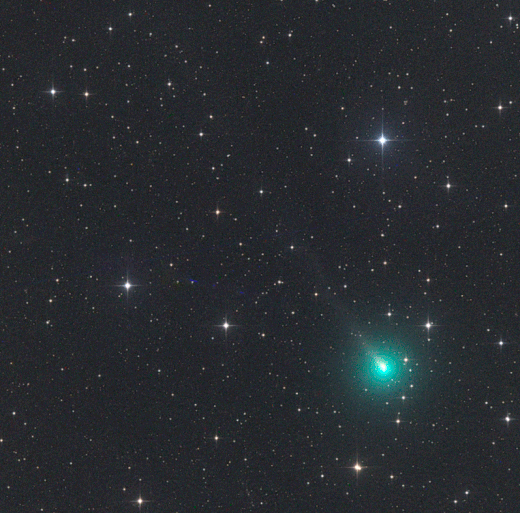8:00 AM (Friday) | *Comet ATLAS continues to brighten, now with an impressive tail, and it could put on quite a dazzling show next month*
Paul Dorian
"According to my observations, the tail of Comet ATLAS is 1.2 degrees long," reports Gerald Rhemann who recorded this animation on Friday, March 27th from his backyard observatory in Eichgraben, Lower Austria (courtesy spaceweather.com)
Overview
About a month ago, Comet ATLAS was very difficult to find, but it is now as bright as an 8th magnitude star and has generated quite an impressive tail. This brightness is hundreds of times brighter than astronomers predicted when it discovered the comet several months ago. While it is still too dim to see with the unaided eye, it is becoming an increasingly easy target for backyard telescopes. The comet is expected to become much brighter by the time it sweeps by the sun closer than Mercury during late May, it could even rival Venus in the evening sky.
The orbit of Comet ATLAS and position as of Thursday, April 2nd; courtesy NASA, theskylive.com
Discussion
Comet ATLAS was discovered by the Asteroid Terrestrial-impact Last Alert System (ATLAS) which is an asteroid impact early warning system developed by the University of Hawaii and funded by NASA. The comet is generally referred to as “ATLAS” from the system that discovered it, but its official name is “C/2019 Y4”. ATLAS consists of two telescopes, 100 miles apart, which automatically scan the whole sky several times every night looking for moving objects. This system will provide one day's warning for a 30-kiloton "town killer," a week for a 5-megaton "city killer," and three weeks for a 100-megaton "county killer". So far, ATLAS has discovered 427 near-earth asteroids and as many as 37 comets including this latest one.
Location of the ATLAS telescopes; courtesy The ATLAS project, NASA
The comet’s last Earth fly-by was sometime around 4000 BC when it was witnessed by early ancient Egyptian farmers as well as Neolithic tribes in Ireland, northern Scotland and across Scandinavia, but this most recent pass was first spotted on December 28, 2019 by ATLAS. The comet is hundreds of times brighter than originally predicted at the time of discovery and there is increasing hope that it will become quite bright when it approaches the sun during the latter part of the month of May. Brightness estimates for Comet ATLAS range from magnitude +1 to -10 which is somewhere between a 1st magnitude star and the waxing crescent moon.
The animation (top) of Comet ATLAS was taken from a backyard observatory (12-inch telescope) in Austria on Friday, March 27th and shows quite an impressive tail. In fact, an estimate of the tails length of 1.2 degrees is roughly equivalent to 3.3 million kilometers or more than twice as wide as the sun. Comet tails are dust and gas that get illuminated by the sun as the comet gets closer. By late May, Comet ATLAS will be only about 0.25 AU away from the sun and getting closer than Mercury (one AU (astronomical unit) is equivalent to the distance between the Earth and the Sun).
Stay tuned…predictions of comet brightness have certainly had mixed results in recent history, but there is increasing hope that this one can put on quite a dazzling show by later next month. By the end of April, Comet ATLAS will be in the constellation of Camelopardalis and best seen just after sunset, in the western twilight sky. After May, ATLAS will continue its journey towards the center of our solar system, getting closer to the Sun which will make it harder to see. It is expected to come back around in June when it may be visible again on its way out of sight once more.
One final note for all amateur astronomers, Venus and the Pleiades are having a rare conjunction tonight with supernova-bright Venus appearing to be inside the star cluster. Venus is about 1000 times brighter than the individual stars of the Pleiades so it might overwhelm them…if so, try binoculars which should help to “bring out” the stars. Look west after sunset - weather permitting.
Meteorologist Paul Dorian
Perspecta, Inc.
perspectaweather.com
Follow us on Facebook, Twitter, YouTube



